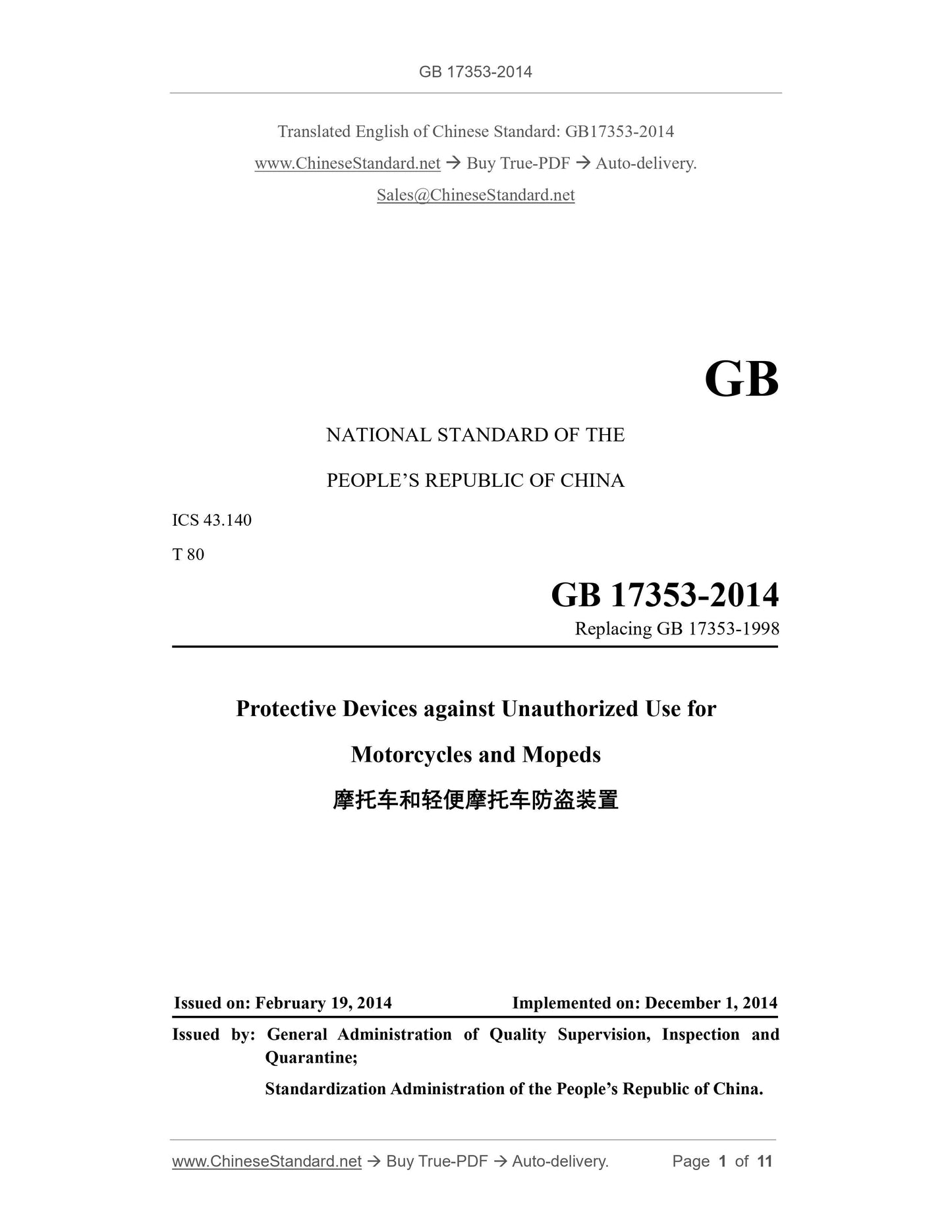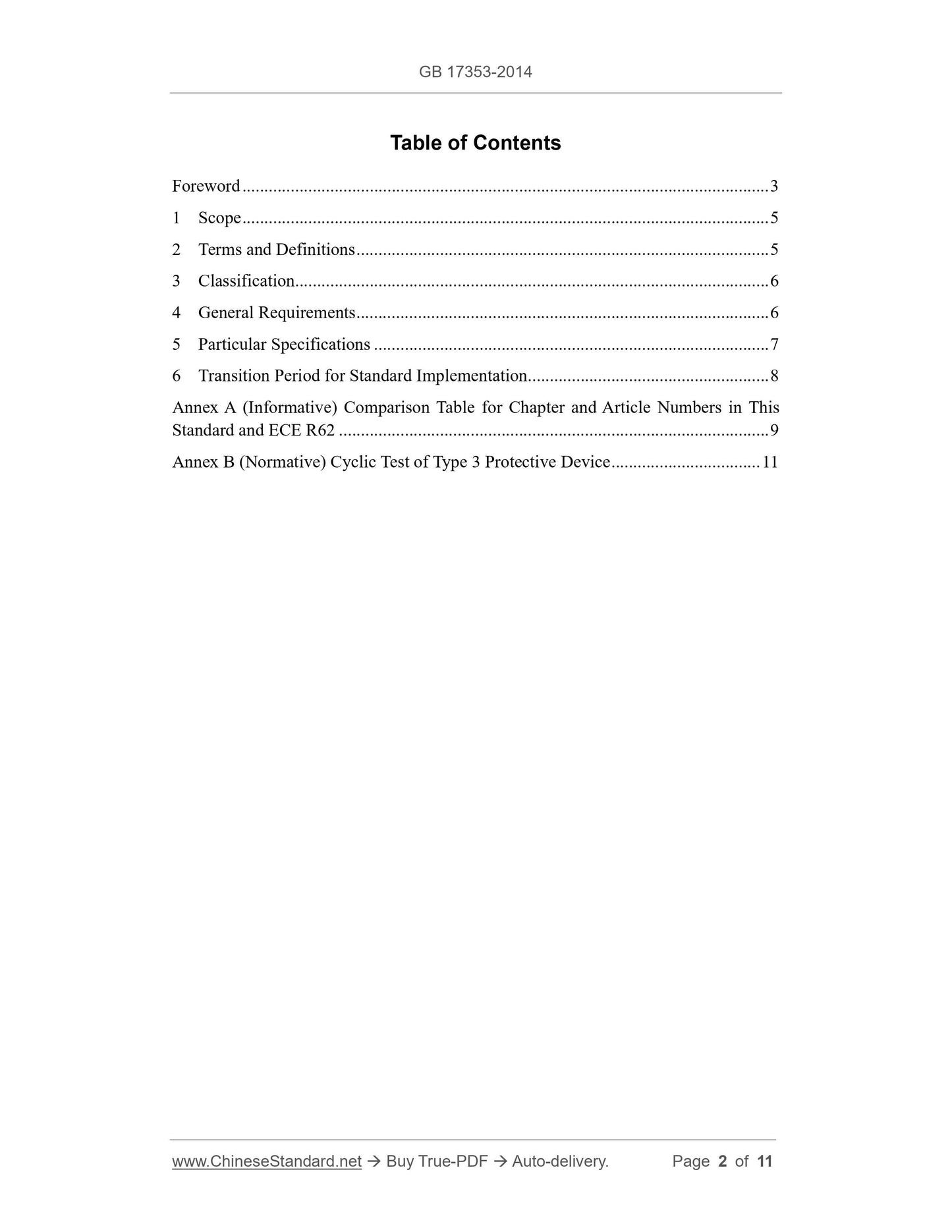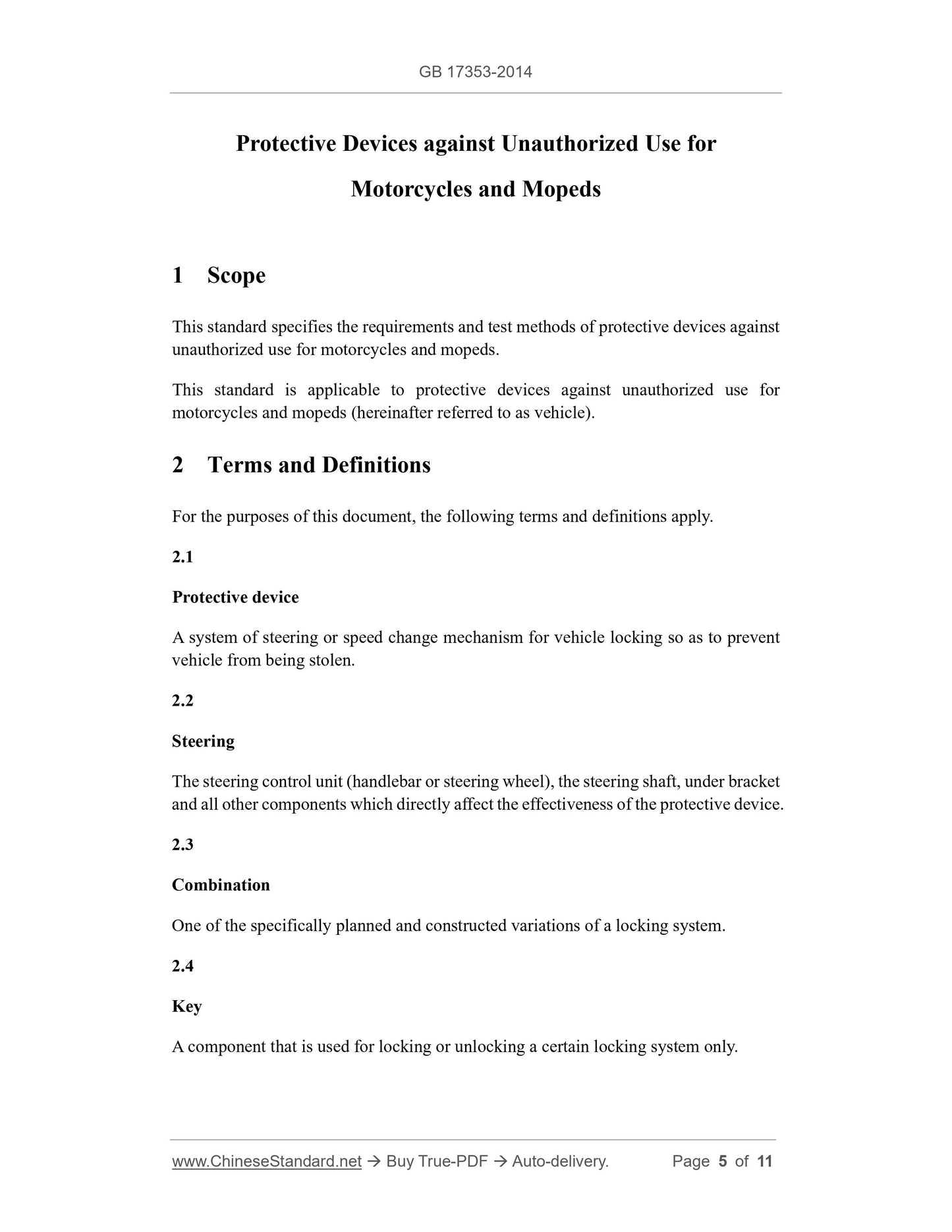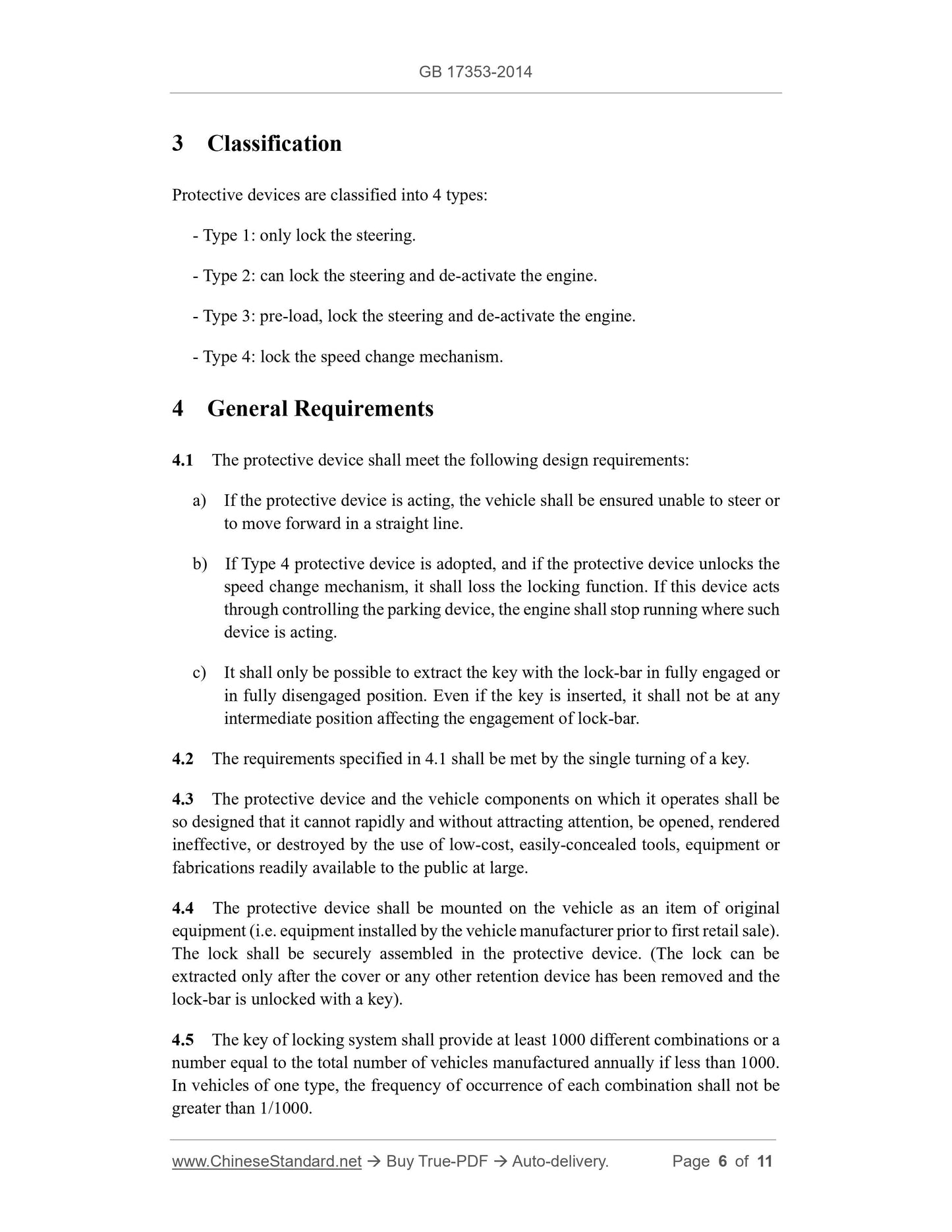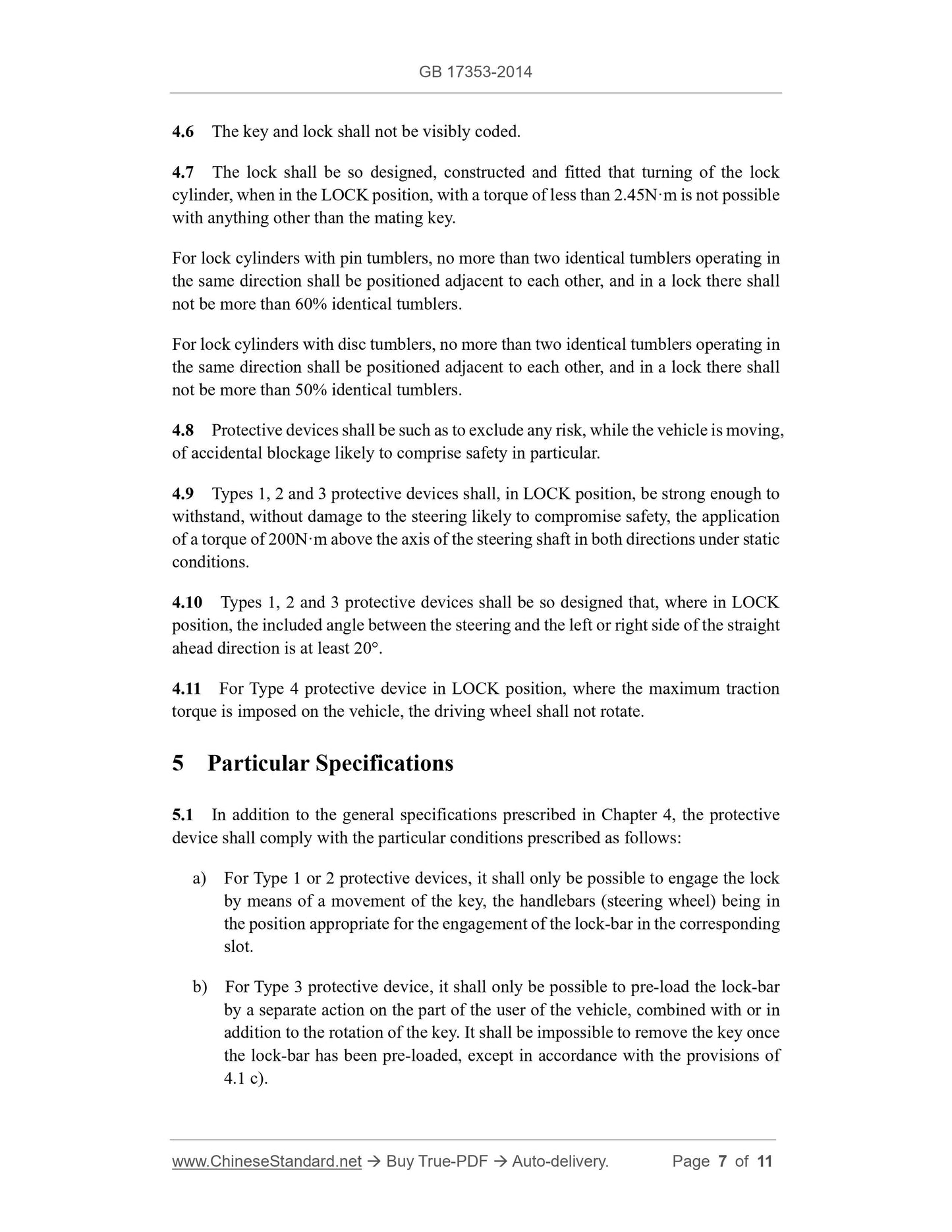1
/
of
5
PayPal, credit cards. Download editable-PDF & invoice in 1 second!
GB 17353-2014 English PDF (GB17353-2014)
GB 17353-2014 English PDF (GB17353-2014)
Regular price
$135.00 USD
Regular price
Sale price
$135.00 USD
Unit price
/
per
Shipping calculated at checkout.
Couldn't load pickup availability
Delivery: 3 seconds. Download true-PDF + Invoice.Newer version: (Replacing this standard) GB 17353-2024
Get QUOTATION in 1-minute: Click GB 17353-2014
Historical versions: GB 17353-2014
Preview True-PDF (Reload/Scroll if blank)
GB 17353-2014: Protective devices against unauthorized use for motorcycles and mopeds
GB 17353-2014
GB
NATIONAL STANDARD OF THE
PEOPLE’S REPUBLIC OF CHINA
ICS 43.140
T 80
Replacing GB 17353-1998
Protective Devices against Unauthorized Use for
Motorcycles and Mopeds
ISSUED ON: FEBRUARY 19, 2014
IMPLEMENTED ON: DECEMBER 1, 2014
Issued by: General Administration of Quality Supervision, Inspection and
Quarantine;
Standardization Administration of the People’s Republic of China.
Table of Contents
Foreword ... 3
1 Scope ... 5
2 Terms and Definitions ... 5
3 Classification... 6
4 General Requirements ... 6
5 Particular Specifications ... 7
6 Transition Period for Standard Implementation ... 8
Annex A (Informative) Comparison Table for Chapter and Article Numbers in This
Standard and ECE R62 ... 9
Annex B (Normative) Cyclic Test of Type 3 Protective Device ... 11
Protective Devices against Unauthorized Use for
Motorcycles and Mopeds
1 Scope
This standard specifies the requirements and test methods of protective devices against
unauthorized use for motorcycles and mopeds.
This standard is applicable to protective devices against unauthorized use for
motorcycles and mopeds (hereinafter referred to as vehicle).
2 Terms and Definitions
For the purposes of this document, the following terms and definitions apply.
2.1
Protective device
A system of steering or speed change mechanism for vehicle locking so as to prevent
vehicle from being stolen.
2.2
Steering
The steering control unit (handlebar or steering wheel), the steering shaft, under bracket
and all other components which directly affect the effectiveness of the protective device.
2.3
Combination
One of the specifically planned and constructed variations of a locking system.
2.4
Key
A component that is used for locking or unlocking a certain locking system only.
3 Classification
Protective devices are classified into 4 types:
- Type 1: only lock the steering.
- Type 2: can lock the steering and de-activate the engine.
- Type 3: pre-load, lock the steering and de-activate the engine.
- Type 4: lock the speed change mechanism.
4 General Requirements
4.1 The protective device shall meet the following design requirements:
a) If the protective device is acting, the vehicle shall be ensured unable to steer or
to move forward in a straight line.
b) If Type 4 protective device is adopted, and if the protective device unlocks the
speed change mechanism, it shall loss the locking function. If this device acts
through controlling the parking device, the engine shall stop running where such
device is acting.
c) It shall only be possible to extract the key with the lock-bar in fully engaged or
in fully disengaged position. Even if the key is inserted, it shall not be at any
intermediate position affecting the engagement of lock-bar.
4.2 The requirements specified in 4.1 shall be met by the single turning of a key.
4.3 The protective device and the vehicle components on which it operates shall be
so designed that it cannot rapidly and without attracting attention, be opened, rendered
ineffective, or destroyed by the use of low-cost, easily-concealed tools, equipment or
fabrications readily available to the public at large.
4.4 The protective device shall be mounted on the vehicle as an item of original
equipment (i.e. equipment installed by the vehicle manufacturer prior to first retail sale).
The lock shall be securely assembled in the protective device. (The lock can be
extracted only after the cover or any other retention device has been removed and the
lock-bar is unlocked with a key).
4.5 The key of locking system shall provide at least 1000 different combinations or a
number equal to the total number of vehicles manufactured annually if less than 1000.
In vehicles of one type, the frequency of occurrence of each combination shall not be
greater than 1/1000.
4.6 The key and lock shall not be visibly coded.
4.7 The lock shall be so designed, constructed and fitted that turning of the lock
cylinder, when in the LOCK position, with a torque of less than 2.45N·m is not possible
with anything other than the mating key.
For lock cylinders with pin tumblers, no more than two identical tumblers operating in
the same direction shall be positioned adjacent to each other, and in a lock there shall
not be more than 60% identical tumblers.
For lock cylinders with disc tumblers, no more than two identical tumblers operating in
the same direction shall be positioned adjacent to each other, and in a lock there shall
not be more than 50% identical tumblers.
4.8 Protective devices shall be such as to exclude any risk, while the vehicle is moving,
of accidental blockage likely to comprise safety in particular.
4.9 Types 1, 2 and 3 protective devices shall, in LOCK position, be strong enough to
withstand, without damage to the steering likely to compromise safety, the application
of a torque of 200N·m above the axis of the steering shaft in both directions under static
conditions.
4.10 Types 1, 2 and 3 protective devices shall be so designed that, where in LOCK
position, the included angle between the steering and the left or right side of the straight
ahead direction is at least 20°.
4.11 For Type 4 protective device in LOCK position, where the maximum traction
torque is imposed on the vehicle, the driving wheel shall not rotate.
5 Particular Specifications
5.1 In addition to the general specifications prescribed in Chapter 4, the protective
device shall comply with the particular conditions prescribed as follows:
a) For Type 1 or 2 protective devices, it shall only be possible to engage the lock
by means of a movement of the key, the handlebars (steering wheel) being in
the position appropriate for the engagement of the lock-bar in the corresponding
slot.
b) For Type 3 protective device, it shall only be possible to pre-load the lock-bar
by a separate action on the part of the user of the vehicle, combined with or in
addition to the rotation of the key. It shall be impossible to remove the key once
the lock-bar has been pre-loaded, except in accordance with the provisions of
4.1 c).
Get QUOTATION in 1-minute: Click GB 17353-2014
Historical versions: GB 17353-2014
Preview True-PDF (Reload/Scroll if blank)
GB 17353-2014: Protective devices against unauthorized use for motorcycles and mopeds
GB 17353-2014
GB
NATIONAL STANDARD OF THE
PEOPLE’S REPUBLIC OF CHINA
ICS 43.140
T 80
Replacing GB 17353-1998
Protective Devices against Unauthorized Use for
Motorcycles and Mopeds
ISSUED ON: FEBRUARY 19, 2014
IMPLEMENTED ON: DECEMBER 1, 2014
Issued by: General Administration of Quality Supervision, Inspection and
Quarantine;
Standardization Administration of the People’s Republic of China.
Table of Contents
Foreword ... 3
1 Scope ... 5
2 Terms and Definitions ... 5
3 Classification... 6
4 General Requirements ... 6
5 Particular Specifications ... 7
6 Transition Period for Standard Implementation ... 8
Annex A (Informative) Comparison Table for Chapter and Article Numbers in This
Standard and ECE R62 ... 9
Annex B (Normative) Cyclic Test of Type 3 Protective Device ... 11
Protective Devices against Unauthorized Use for
Motorcycles and Mopeds
1 Scope
This standard specifies the requirements and test methods of protective devices against
unauthorized use for motorcycles and mopeds.
This standard is applicable to protective devices against unauthorized use for
motorcycles and mopeds (hereinafter referred to as vehicle).
2 Terms and Definitions
For the purposes of this document, the following terms and definitions apply.
2.1
Protective device
A system of steering or speed change mechanism for vehicle locking so as to prevent
vehicle from being stolen.
2.2
Steering
The steering control unit (handlebar or steering wheel), the steering shaft, under bracket
and all other components which directly affect the effectiveness of the protective device.
2.3
Combination
One of the specifically planned and constructed variations of a locking system.
2.4
Key
A component that is used for locking or unlocking a certain locking system only.
3 Classification
Protective devices are classified into 4 types:
- Type 1: only lock the steering.
- Type 2: can lock the steering and de-activate the engine.
- Type 3: pre-load, lock the steering and de-activate the engine.
- Type 4: lock the speed change mechanism.
4 General Requirements
4.1 The protective device shall meet the following design requirements:
a) If the protective device is acting, the vehicle shall be ensured unable to steer or
to move forward in a straight line.
b) If Type 4 protective device is adopted, and if the protective device unlocks the
speed change mechanism, it shall loss the locking function. If this device acts
through controlling the parking device, the engine shall stop running where such
device is acting.
c) It shall only be possible to extract the key with the lock-bar in fully engaged or
in fully disengaged position. Even if the key is inserted, it shall not be at any
intermediate position affecting the engagement of lock-bar.
4.2 The requirements specified in 4.1 shall be met by the single turning of a key.
4.3 The protective device and the vehicle components on which it operates shall be
so designed that it cannot rapidly and without attracting attention, be opened, rendered
ineffective, or destroyed by the use of low-cost, easily-concealed tools, equipment or
fabrications readily available to the public at large.
4.4 The protective device shall be mounted on the vehicle as an item of original
equipment (i.e. equipment installed by the vehicle manufacturer prior to first retail sale).
The lock shall be securely assembled in the protective device. (The lock can be
extracted only after the cover or any other retention device has been removed and the
lock-bar is unlocked with a key).
4.5 The key of locking system shall provide at least 1000 different combinations or a
number equal to the total number of vehicles manufactured annually if less than 1000.
In vehicles of one type, the frequency of occurrence of each combination shall not be
greater than 1/1000.
4.6 The key and lock shall not be visibly coded.
4.7 The lock shall be so designed, constructed and fitted that turning of the lock
cylinder, when in the LOCK position, with a torque of less than 2.45N·m is not possible
with anything other than the mating key.
For lock cylinders with pin tumblers, no more than two identical tumblers operating in
the same direction shall be positioned adjacent to each other, and in a lock there shall
not be more than 60% identical tumblers.
For lock cylinders with disc tumblers, no more than two identical tumblers operating in
the same direction shall be positioned adjacent to each other, and in a lock there shall
not be more than 50% identical tumblers.
4.8 Protective devices shall be such as to exclude any risk, while the vehicle is moving,
of accidental blockage likely to comprise safety in particular.
4.9 Types 1, 2 and 3 protective devices shall, in LOCK position, be strong enough to
withstand, without damage to the steering likely to compromise safety, the application
of a torque of 200N·m above the axis of the steering shaft in both directions under static
conditions.
4.10 Types 1, 2 and 3 protective devices shall be so designed that, where in LOCK
position, the included angle between the steering and the left or right side of the straight
ahead direction is at least 20°.
4.11 For Type 4 protective device in LOCK position, where the maximum traction
torque is imposed on the vehicle, the driving wheel shall not rotate.
5 Particular Specifications
5.1 In addition to the general specifications prescribed in Chapter 4, the protective
device shall comply with the particular conditions prescribed as follows:
a) For Type 1 or 2 protective devices, it shall only be possible to engage the lock
by means of a movement of the key, the handlebars (steering wheel) being in
the position appropriate for the engagement of the lock-bar in the corresponding
slot.
b) For Type 3 protective device, it shall only be possible to pre-load the lock-bar
by a separate action on the part of the user of the vehicle, combined with or in
addition to the rotation of the key. It shall be impossible to remove the key once
the lock-bar has been pre-loaded, except in accordance with the provisions of
4.1 c).
Share
